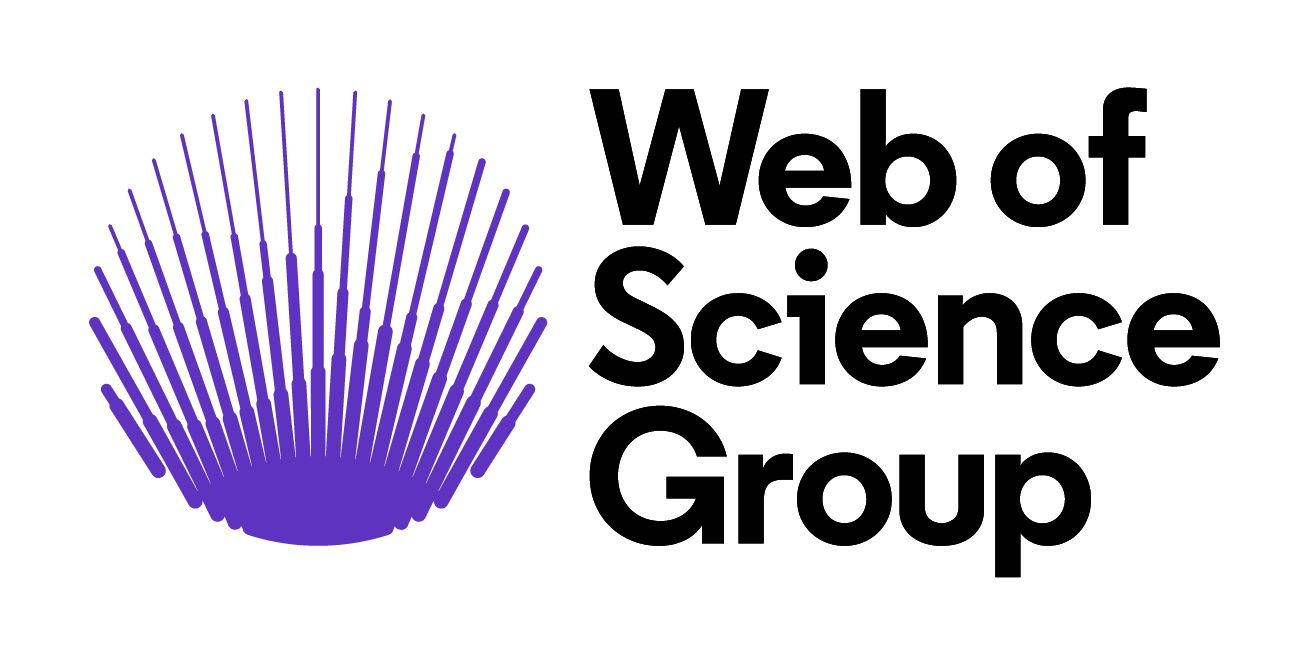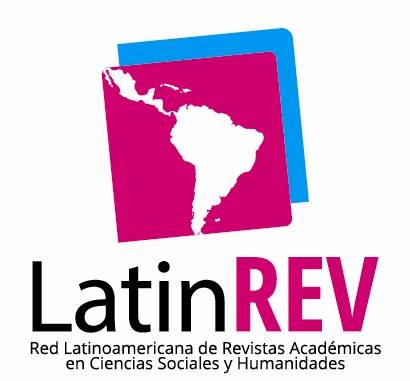Género, infancia y antropología frente al cambio climático
Gender, children and anthropology in the face of climate change
En este artículo, se evidencian datos y conceptos articulados por la investigacion de las agencias internacionales (UNWoman, UNICEF, WTO, WHO), con respecto a las consecuencias del cambio climático. Además que las migraciones, son las relaciones de género y el estatus generacional los más involucrados en los cambios, a menudo, gravísimos. La autora se plantea entonces una evaluación de si la antropología pueda contribuir - por medio de sus experiencias etnográficas de estudio del cambio climático – en realizar un avance que podría ser constituido por una antropología de la implementación para la igualdad en las situaciones de cambio climático.
This contribution highlights the data and concepts, articulated by the research of international agencies (UNWoman, UNICEF, WTO, WHO) regarding the consequences of climate change. Besides migrations, gender relations and generational status are often the most involved aspects in dramatic changes. The author then addresses the question of whether anthropology can contribute, by the ethnographic study experiences on climate change, in taking another step that could be constituted by an anthropology of the implementation for equality in climate change situations.
Visitas al artículo
Métricas Dimensions
Métricas PlumX
Descargas
Recibido: 29/08/2018
Aprobado versión definitiva: 26/10/2018
GENDER, CHILDREN AND ANTHROPOLOGY IN THE FACE OF CLIMATE CHANGE
GÉNERO, INFANCIA Y ANTROPOLOGIA FRENTE AL CAMBIO CLIMATICO
Nadia Breda*
DOI: http://dx.doi.org/10.15648/Coll.1.2019.11
ABSTRACT
This contribution highlights the data and concepts, articulated by the research of international agencies (UNWoman, UNICEF, WTO, WHO) regarding the consequences of climate change. Besides migrations, gender relations and generational status are often the most involved aspects in dramatic changes. The author then addresses the question of whether anthropology can contribute, by the ethnographic study experiences on climate change, in taking another step that could be constituted by an anthropology of the implementation for equality in climate change situations.
Keywords: Climate Change; Gendered perspective; migration; anthropology of climate change; anthropology of implementation for equality.
RESUMEN
En este artículo, se evidencian datos y conceptos articulados por la investigacion de las agencias internacionales (UNWoman, UNICEF, WTO, WHO), con respecto a las consecuencias del cambio climático. Además que las migraciones, son las relaciones de género y el estatus generacional los más involucrados en los cambios, a menudo, gravísimos. La autora se plantea entonces una evaluación de si la antropología pueda contribuir - por medio de sus experiencias etnográficas de estudio del cambio climático – en realizar un avance que podría ser constituido por una antropología de la implementación para la igualdad en las situaciones de cambio climático.
Palabras clave: cambio climático; perspectiva de género; migración; antropología del cambio climático; antropología de la implementación para la igualdad.
Introduction
It is nowadays well known that between the biggest social and human consequences of climate change there are migrations1. The victims of climate change are defined environmental refugees, and, often, they cannot access refugee status. World Health Organization (WHO), wrote that climate change can affect migration in three distinct ways:
First, the effects of warming and drying in some regions will reduce agricultural potential and undermine ‘ecosystem services’ such as clean water and fertile soil. Second, the increase in extreme weather events – in particular, heavy precipitation and resulting flash or river floods in tropical regions – will affect ever more people and generate mass displacement. Finally, sea level rise will destroy extensive and highly productive low- lying coastal areas that are home to millions of people who will have to permanently relocate. In this context, health challenges can involve among others, the spread of communicable diseases and an increase in the prevalence of psychosocial problems due to stress associated with migration. The human and social consequences of climate change in this context are very poorly studied, if at all2.
There is also another important category of victims of climate change, although they do not necessarily carry out cross-border migrations, but rather minor "shifts" in space and, above all, enormous shifts in meanings, contexts, experiences, economies, social and cultural relations. Not for this reason, these social and human effects are less significant, and they are also among the least studied. All these movements are not "gender-neutral", but rather connoted from the point of view of "gender": climate change, migration, movements affect women and men in different ways, and they are shaped, by gender roles and responsibility.
Figure 1. Climate change and changing farmland
Source: http://publications.iom.int/system/files/pdf/mecc_outlook.pdf, p. 109.
This article is a reflection on how to turn the perspective on climate change as "gendered", by analyzing, firstly, some reports of major international agencies and, afterwards, trying to hypothesize if and how anthropology can act, as a discipline able to encourage an “implementation of the recommendations” of these same agencies (Binazzi Daniel, 2018). As C. B. Brettell wrote “Today, for immigrants of the past and the present, we ask questions as such: to what extent can man and women who migrate be viewed as independent social actors pursuing their own goals and strategies?”. Brettell underlines that the assumption is that the entire migration process is gendered, in both its causes and its consequences. As a good example of “intersectionality” crossing the concept of climate change and gender, the United Nations produced a document, titled “Introduction to Gender and Climate Change” where the question “why is gender and climate change relationship important?”3 is tackled and resulted in a “Gender Action Plan”4 (GAP) by UNFCCC (United nation Framework Convention on Climate Change). Often in this type of analysis, the question of the negative effects of climate change concern women, together with their children.
In fact, it is more likely that the children find themselves accompanied by mothers, rather than by fathers, since often, fathers are absent and children stay with mothers, at least up to a certain age. For this reason, the UNICEF Office of Research, presented, in a clear way, the impacts of climate change on children, their possible adaptation, the relationship of this problems with the Children's Rights and Justice5. In this article, I will therefore analyze some data and suggestions concerning women, girls, children and society.
The aim of this contribution is to introduce a sector of studies that can be identified as an intersectionality between gender, children and anthropology in relation to the problems of climate change. The above documents are the starting point for the reflection I am here presenting, according to three points: the relation of climate change with gender issues; the relation of climate change with children rights; and finally, the possible role (not simple, nor so evident) of anthropological studies in this thematic, face up to the climate change. I will search to find in these documents some quantitative insights and data that I wish to intersect with the qualitative anthropological approach.
As an anthropologist, I try to show that one of the possible contributions of anthropology to the problem of climate change could be the capacity of implementation for equality, understood not as "equality" or "equidad", which has no legal support and, therefore, it remains aleatory and moral, but rather as "igualdad". The latter must be accompanied by the fight against discrimination (as supported by the Declaration of Human Rights, and by the Convention on the Rights of the Child, also incorporated in most of the Constitutions of the world), in order not to remain a non-concrete, ideological and defective “igualdad”.
Gender and climate change connections
The significant slogan by UN document that I would like to put in the foreground is that “Climate change is not gender-neutral”6. A changing climate poses risks for all of humanity.
However, for women and girls, in particular, many of whom spend a huge amount of time searching for food, fuel and water, or struggling to grow crops, the impact is tremendous. “In fact, when disasters strike, women are more likely than men to die, such as the case of the 2004 Asian tsunami where 70 per cent of the fatalities were women”7. Many times, this event was confirmed8. UNDP affirms that “Women and children are 14 times more likely than men to die during a disaster”9.
Figure 2. Climate-related disaster and female mortality
Source: http://publications.iom.int/system/files/pdf/mecc_outlook.pdf, p.. 109.
For the anthropologist, who is interested in communities of rural areas, small groups of gatherers, developing or emerging societies or in poverty, it is particularly relevant to know what this dossier illustrates. In particular, it highlights that "climate change has a greater impact on those sections of the population, in all countries, that are most reliant on natural resources for their livelihoods and/or who have the least capacity to respond to natural hazards, such as droughts, landslides, floods and hurricanes. Women commonly face higher risks and greater burdens from the impacts of climate change in situations of poverty, and the majority of the world’s poor are women.” (UNFCCC, Introduction to Gender and climate change).
The report of UN WOMEN WATCH is also focused on the gender inequality theme face to climate change, and a specific report is dedicated to Women, Gender Equality and Climate Change. Here, we can read that:
Existing gender inequalities constrain women and girls’ potential to be leaders in climate responses. As gender inequalities limits women and girls’ ability to adapt and respond to climate change impacts, they often bear the brunt of the impacts. The disproportionate effects of energy poverty on women and girls limits their access to education and employment due to the time spent on biomass collection. They also face significant health and safety risks from household air pollution, carrying heavy fuel loads and the lack of exterior lighting. […]. Gender inequalities, in turn, are further exacerbated by climate-related hazards, resulting in what the IPCC found to be higher workloads, occupational hazards indoors and outdoors, psychological and emotional stress, and mortality for women as compared to men10.
Figure 3. Women, gender equality and water resources in the context of climate change
Source: http://www.un.org/womenwatch/feature/climate_change/factsheet.html#humanrights, without page.
It is therefore based on these data that it is increasingly urgent to turn, as gendered, perspective on the issue of migration. The following table is an example of how language and concepts should be rewritten according to a gendered perspective, passing from often correct, but generic phrases, to details that highlight that someone is suffering the consequences, differently, from others. For example, extreme weather events generate not only dramatic shifts in farming and land use, but more precisely increased violence against women and girls. It is interesting that this change of perspective is an elaboration proposed by the United Nations WHO itself.
Figure 4. A
gendered
perspective on climate change
Source: https://www.who.int/globalchange/publications/reports/final_who_gender.pdf , p. 3.
This dramatic data should not be read into a victimization perspective, but rather highlighting the agency of women as protagonists of change, alternative solution, etc. In fact, women, girls, and children are also key leaders and agents of change. They play a critical, but often unrecognized, role in climate action as entrepreneurs and households energy managers. In Dankelman11 (2010), there are many examples of how women around the world organize and build resilience and adapt to climate change and the role they are playing in climate change mitigation. Many “stories of change” can be read (and watched in video), in UNWOMEN report Gender equality, women’s empowerment and climate change12.
For example, Caribbean women (from Barbados, Grenada and Jamaica) are protecting their crops, through green technologies. They sell them at local markets in their communities and to tourists. Moreover, through workshops, women farmers are learning more sustainable farming techniques and securing their livelihoods. The project aims to reduce women’s lack of access to resources. Indigenous women in Peru combat climate change and boost economy. In addition to healthier crops and improved incomes for the community, the program has boosted indigenous women’s participation in public spaces and decision-making. In Moroccan oases, a group of women have found a unique way to earn an income and mitigate the effects of climate change on their environment by cultivating medicinal and aromatic plants, using renewable energy. In Bangladesh 19,100 women have built resilience against climate change, by building better systems of support and preparation for disaster.
Figure 5. Gender equality, women’s empowerment and climate change
Source: http://lac.unwomen.org/en/noticias-y-eventos/en-la-mira/climate-change, without page.
In conclusion, according to the reports taken into consideration, there is a gender problem in the face of climate change and there is also the possibility of facing it (as the positive stories highlighted), allowing women to acquire capacity and power to act.
What is necessary is to apply “a gender lens to climate change”. This could reveal solutions to this intractable problem. “Notably, systematically addressing the persistent gender gaps in the response to climate change is one of the most effective mechanisms to build climate resilience”13. At the opposite:
a gender-blind policies run the risk of proposing inappropriate responses to climatic and environmental problems and are less likely to succeed. A gendered analysis is therefore crucial to developing and deploying responsive strategies that are effective and fair to both female and male environmental migrants, and that do not exacerbate existing gender inequalities or create new ones. Furthermore, comprehensive gender- sensitive considerations help assess the different impacts of policies and legislation on women and men, as part of different social groups, to ensure that actions do not exclude or harm other social groups14.
Children into the climate change
Children and young people represent 30 per cent of the world’s population. They are more vulnerable than adults to harmful effects of climate change. UNICEF said that the brunt of the impact of climate change is borne by children15.
The World Health Organization (2012) has estimated that children suffer more than 80 per cent of the morbidity and mortality produced by climate change – with those in poorer areas inevitably being the worst affected. “As rising temperatures produce a spread of malaria into previously unaffected areas, for example, it is the lives of children that are most endangered. When people’s sources of livelihood are disrupted, whether through flooding or extreme weather events, it is the youngest members of the community who will suffer most from undernutrition and diarrheal disease.”16.
Figure 6. Rising temperature, malaria and children death
Source: https://www.unicef.org/publications/files/Unless_we_act_now_The_impact_of_climate_change_on_children.pdf., p. 49
The report titled Unless we act now. The impact of climate change on Children (UNICEF 2015) is very impressive on exploring from a quantitative point of view the situation of children facing climate change. Some data are summarized by the report: 2,3 billion children has important implications for assessing the impact of climate change; nearly 160 million children live in area of high or extremely high drought severity and drought also can exacerbate inequities; 530 million children live in extremely high flood occurrence zone (Figure 7, 8, 9, 10)
Figures 7. Children in the world
Source: https://www.unicef.org/publications/files/Unless_we_act_now_The_impact_of_climate_change_on_children.pdf, p. 15.
Figure. 8, Children and drought
Source: https://www.unicef.org/publications/files/Unless_we_act_now_The_impact_of_climate_change_on_children.pdf, p. 23.
Figures 9, Drought exacerbating inequities.
Source: https://www.unicef.org/publications/files/Unless_we_act_now_The_impact_of_climate_change_on_children.pdf, p.27.
Figures 10. Children and flood
Source: https://www.unicef.org/publications/files/Unless_we_act_now_The_impact_of_climate_change_on_children.pdf, p.31.
Particularly important for the anthropologists, is the correlation between indigenous children and climate change. In fact, climate change has disproportionate impact above all those social groups, whose life styles are strictly linked to the natural environment, like indigenous people. All anthropologists know that indigenous people are the humans that less have contributed to climate change and greenhouse gas emissions, but “estimated 370 million indigenous adults and children in some 90 countries around the world are at particular risk of facing the direct consequences of climate change”. Exactly because of their close, dependent relationship with the environment, the indigenous people is the more threated population today, and this is the paradox. Despite indigenous people are strictly correlate with areas of high biological diversity, and they represent the best sustainable livehood and practices, they are suffering the consequences of climate change impacts. As UNICEF underlays, children, and especially young children, are less equipped to deal with deprivation and stress due to their particular physical, social and psychological characteristics. This makes them particularly vulnerable to the effects of disasters17. Solutions are low cost and well known, for example, need to sleep, antibiotics and rehydration for diarrhea. But, disaster impact analysis often.
Focuses on the immediate economic loss of the disaster event and the cost of rehabilitation and repair of major infrastructure – the immediate and long-term human dimensions of loss are not factored into these costs. Disaster risk reduction programs therefore tend to focus on the protection of the economy and structures rather than looking at vulnerability and difference within and between communities. Much climate change adaptation has followed suit. But disaster impacts persist into the long-term, well beyond initial mortality and infrastructural damage and may include negative impacts on health, education, nutrition and morbidity; for children these can lead to lifelong impacts on well- being and achievement in their adult lives.
Inequality undermines the world’s capacity to care for its most vulnerable, youngest citizens, those who should be protected, by the U. N. Convention on the Rights of the Child (UNCRC). In school, young people often learn about climate change, but not necessarily about what they can do about it. Only when children are put into the condition of working together, they generate agency and action. “the sense of cohesion and partnership with their peers increases their belief in themselves as agents of change”, and “a move away from a concept of vulnerability involving passivity and suffering... means increasing capacities... and therefore fostering and enabling people’s resilience”.
There are many positive examples from
all over the world of young people, who are making a difference and
offering their special perspective. They are raising awareness in
their own communities, organizing conservation projects, promoting
renewable energy and taking political action in support of
sustainability and climate justice. They are not only developing
their own potential, as future leaders but also demonstrating their
leadership on the issue of climate change in the here
and now. Involving children
and young people in the process can help to unblock the logjam that
currently exists in climate negotiations.
Participation of young people is no longer something to which international organizations can simply pay lip service – it is a necessity, if the interests of future generations of humanity are to be safeguarded. For example, through programming in the Philippines, “children and young people are producing their own public service announcements to warn their friends and communities about the impacts of climate change. Using video and audio recordings, children tell their peers and the wider community what they’ve learned about climate change in an easy-to-understand way”18. Once again, the international agencies' documents push to accentuate the concept of agency, an agency that must be revisited in relation to this new phenomenon, climate change, and which must be supported and strengthened as a factor of change.
Anthropology and climate change
There is an important element that emerge in overbearing way in climate change framework and that is too much hidden in the data: the uncertainty that emerge from different interpretations of climate change, from the dynamics of denial of climate change or indifference toward the problem, from the failure of proposed solutions at climate change. The local, social and cultural aspect of climate change underline and highlight all the inherent contradictions of the societies and make uncertain and contradictory many possible (or proposed) solutions. It is with this uncertainty dimension that the “recommendations”, and “requests” by international agency, collide. This uncertainty origins by hard verifiability of everyday routine of horizon of climate change. The ambiguity between individual perception of climate change and the mass media narration increase our sense of disorientation. Elena Bougleux (2017) explain that climate change phenomenon put in crisis individual agency: the prevailing narration on climate change describes unfamiliar scenarios struck by exceptional events, that rarely can be connected with personal experiences.
How to fill the gap? How to translate climate change into a daily and tangible experience? This is very important point, because filling the gap is exactly the process of implementation for equality at which anthropology could contribute. Anthropology proposes some suggestions: paying close attention to the local dimension, making the climate change visible and tangible in the everyday experiences, being able to recognize the social different dimensions of the phenomenon, like gender and generational differences. The initial length of the anthropology in researching on this ‘wicked problem’ has been exceeded, when anthropology started dialoguing with the other disciplines, other knowledge, other methodologies.
The most important contribution of anthropology at climate change debate19, bringing out the social and cultural dimension of climate change, consists in 3 points:
The qualitative methodology in researching local knowledge, local practices, local communities.
The holistic pictures of the field that anthropology can portray.
The historical prospective that demonstrate the possibility of change.
Anthropology seeks to move the everyday and even the scientific epistemology from a "tunnel vision" towards a "systemic and complex” vision of the problem of climate change. There are today some important anthropological works that show that anthropology is able to do these actions:
To switch from simple ethnographic encounter to collective action (Crate, S. A. and Nuttall, M. 2009),
To move from individual to collective work into and with communities and interdisciplinary groups (Tsing A., 2009);
To found more incisive, effective solutions, avoiding “climate reductionism” (J. Barnes, Dove, M. et al., 2013);
To collaborate with local population for the adaptation and resilience,
To found/discover local specificities into the relationship between society and nature that make/create differences in the climate change framework and consequently in the proposed solutions (Hastrup K., 2014; K. Hastrup and Rubow C., 2014).
To facilitate the relationship of locally grounded approach with global approach and models (Greschke H. and Tischler J., 2015).
To conclude, in my opinion, the anthropology in the framework of climate change could be the instrument of implementation for gender equality. The ethnographic approach and insights can highlight, with data from the field, concrete aspects of social and cultural dimension of climate impacts, like, for example, the active agency of women and children.
I conclude with reference to two interesting scientists. Mike Hulme20 exhorts at adopting a very careful look at the location, the daily dimension and the individual experience of climate change. This is exactly the opposite of what is invoked only on a symbolic level, through the large global conferences on climate, beginning with the COP, faceless subjects far from the sphere of experience. Elena Bougleux (2017, p. 88), explains that "Nobody can talk about climate change alone. Neither the pure climatologists - nor the anthropologists are sufficient alone. All knowledge in the climatic field must be considered important, and not secondary, the satellite data and the knowledge elaborated by the local communities are on the same level of relevance and necessity, perhaps for the first time in history" (Id.).
This is what makes the presence of anthropology important with its ethnographic works in the field. This is the work that can make the climate change framework less uncertain and less abstract and thus make the implementation for equality that is necessary to overcome the gender gap possible. The mentioned reports have highlighted, in fact, the problem of inequality between genders and inequality for children, as the gap to overcome. Data on climate change have shown us the consequences of climate change for women and children. Migrations resulting from climate change must be made "gendered".
Anthropology can make a contribution as anthropology of the implementation of rights, of / for overcoming the gaps. At the end, it would be a question of constructing a new field for anthropology, an anthropology of the implementation, which asks what contribution anthropology can make to achieve the objectives set, by the most important and significant international conventions, expressed in the reports of international institutions such as those here analyzed. If, as intergovernmental agencies and social studies are now agreed, migration is not gender-neutral, anthropology can contribute not only with the fieldwork, but also with work for implementation for equality in a gendered perspective on climate change consequences.
Bibliographic references
American Anthropological Association (2014), (Fiske, S.J., Crate, S.A., Crumley, C.L., Galvin, K., Lazrus, H., Lucero, L. Oliver- Smith, A., Orlove, B., Strauss, S., Wilk, R.), Changing the Atmosphere. Anthropology and Climate Change. Final report of the AAA Global Climate Change Task Force, December 2014, Arlington, VA.
Baer, H., y Singer M. (2014). The anthropology of Climate Change: An Integrated Critical Perspective, New York: Routledge.
Barnes, J., M. Dove et al. (2013). Contribution of Anthropology to the study of Climate Change, Nature Climate Change, n. 3, pp. 541-544.
Binazzi Daniel, A. (2018). Los Derechos Humanos de Niñas, Niños y Adolescentes y el nuevo compromiso internacional para la Agenda 2030. Debates Latinoamericanos 32.
Bougleux ,E. (2015). Issues of Scale in the Anthropocene, Archivio Anthropologico Mediterraneo, XVIII, 17(1), 67-73.
Bougleux, E. (2017). Incertezza e cambiamento climatico, Etnoantropologia, 5 (1).
Chakrabarti, D. (2009). The Climate of History, Critical Enquiry, 35 (2): 197-222.
Crate S. A. (2011). Climate and Culture: Anthropology in the Era of Contemporary Climate Change, Annu. Rev. Anthropol, 40: 175-94.
Crate, S. A. and M. Nuttall (2016). Anthropology and Climate Change. From Actions to Transformations, London: Routledge.
Crutzen, P.J. and Stoermer E.F., (2000). The Anthropocene. IGBP Newsletter. 41:17-18.
Dankelman I., (ed.) (2010). Gender and Climate Change: An Introduction. New York: Earthscan ed., New York.
Dove M. (ed.) (2014). The Anthropology of Climate Change. A Historical Reader, Malden: Wiley Blackwell.
Edwards, Paul N. 2913, A Vast Machine, MIT Press.
Gibson H. e Venkateswar S., (2015) Anthropological Engagement with the Anthropocene. A critical Review, Environment and Society: Advances in Research, 6: 5-27 .
Graef Dana J., Can we “See” Climate Change? https://www.sapiens.org/column/the-climate-report/climate-change-evidence/; 19.oct. 2017
Greschke, H. and Tischler, J. (eds.), (2015). Grounding Global Climate Change, Contribution from Social and Cultural Sciences, New York and London: Springer.
Hastrup, K. and Rubow C. (2014). Living with Environmental Change: Waterworlds, London:Routledge.
Hastrup, K. (ed.). (2014). Anthropology and Nature, New York and London: Routledge.
Hulme M. (2013). Exploring Climate Change through Science and in Society, Earthscan Routledge ed., London and New York.
Hulme, M., (2009). Why we disagree about Climate Change. Understanding Controversy, Inaction and Opportunity, Cambridge, Cambridge U.P.
IPCC 2014, Climate Change 2014: Impacts, Adaptation, and Vulnerability. Working Group II Report, Cambridge: Cambridge University Press.
Latour B. (2014). Anthropology at the Time of the Anthropocene - a personal view of what is to be studied, lecture at American Anthropological Association.
Latour B. (2015). Facing Gaia. Huit conférences sur le nouveau régire climatique, Paris: La Découverte.
Norgaard, K. M. (2011). Living in Denial: Climate Change, Emotions, and Everyday Life, MIT Press.
Pokrant, B., Stocker L. (2011). Anthropology, Climate Change and Coastal Planning, in H. Kopnina H., and E. Soreman-Ouiman (eds.), Environmental Antropology Today, London: Routledge.
Tsing, A. The Mutsutake Worlds Research Group. https://people.ucsc.edu/~atsing/migrated/matsutake/group.html.
Para citar este artículo:
Breda, N. (2019). Género, infancia y antropología frente al cambio climático. Collectivus, Revista de Ciencias Sociales, 6(1), 197-214. DOI: http://dx.doi.org/10.15648/Coll.1.2019.11
* PhD in Ethnoanthropological. Sciences. Professor of Cultural Anthropology, University of Florence, Italy, Dept. SCIFORLILLPSI, 48 Via Laura, 50121, Firenze (FI) Italia. Correo electrónico: nadia.breda@unifi.it
1 Source: IOM UN Migration, Migration Environnement and Climate Chamge (MECC); Environmental Migration Portal https://www.iom.int/migration-and-climate-change; https://environmentalmigration.iom.int; IOM, UN Migration, World migration report 2018, https://www.iom.int/wmr/world-migration-report-2018; IOM Outlook on Migration, Environment and Climate Change, REPORT 2014 http://publications.iom.int/system/files/pdf/mecc_outlook.pdf BRIEF 13, “A gender approach to environmental migration” ; Women’s Manifesto on Climate Change https://www.wen.org.uk/all-resources/
2 Source: WHO, 2005, Gender, climate change and Health, https://www.who.int/globalchange/publications/reports/final_who_gender.pdf
3 Source: UNFCCC, Introduction to gender and Climate Change, https://unfccc.int/topics/gender/the-big-picture/introduction-to-gender-and-climate-change. See also WEDO , Womens’s Environment & Development Organization, http://unfccc.int/files/gender_and_climate_change/application/pdf/sb46_entrypointsdocument.pdf, and the role of Lima Work Programme on Gender, http://unfccc.int/files/parties_observers/submissions_from_observers/application/pdf/883.pdf
4 Source: “Gender and climate change” Draft conclusion, https://unfccc.int/sites/default/files/resource/docs/2017/sbi/eng/l29.pdf
5Source: The full UNICEF 2014 report here, https://www.unicef-irc.org/publications/pdf/ccc_final_2014.pdf, see also UNICEF 2015 https://www.unicef.org/publications/files/Unless_we_act_now_The_impact_of_climate_change_on_children.pdf
6 Source: http://www.undp.org/content/undp/en/home/blog/2015/11/17/Climate-change-is-not-gender-neutral.html, 17 Nov 2015 by Ana Maria Currea, Communications and Knowledge Management Specialist, GEF Small Grants Programme, UNDP.
7 Data by UNWOMEN Americas and the Caribbean, “Gender equality, women’s empowerment and climate change”, http://lac.unwomen.org/en/noticias-y-eventos/en-la-mira/climate-change
8 See for exemple https://unfccc.int/files/gender_and_climate_change/application/pdf/leveraging_cobenefits.pdf ;
https://www.oxfam.org.nz/sites/default/files/reports/The_tsunami_impact_on_women.pdf;
9 Source: “Gender and disaster risk reduction, UNDP, Asia and the Pacific, Policy Brief, http://www.undp.org/content/dam/undp/library/gender/Gender%20and%20Environment/PB3-AP-Gender-and-disaster-risk-reduction.pdf
10 This is a very important report dedicated to intersectionality approach that is of interest for us. See for more argument UN WOMEN WATCH, Women, Gender Equality and Climate Change http://www.un.org/womenwatch/feature/climate_change/factsheet.html#humanrights
11 Dankelman is one of the authors of the seminal Women and the Environment in the Third World: Alliance for the Future (1988) which first exposed the links between environmental degradation and unequal impacts on women.
13Source: https://unfccc.int/files/gender_and_climate_change/application/pdf/egmreport_bonn_final_25_november_2015.pdf
14 Source: IOM Outlook on Migration, Environment and Climate Change, REPORT 2014 http://publications.iom.int/system/files/pdf/mecc_outlook.pdf , p. 104.
15 Source: UNICEF Office of Research (2014). ‘The Challenges of Climate Change: Children on the front line’, Innocenti Insight, Florence: UNICEF Office of Research. The full UNICEF report here, https://www.unicef-irc.org/publications/pdf/ccc_final_2014.pdf
16 Source: UNICEF (2015), Unless we act now. The impact of climate change on Children, this report aims to build the evidence base on children and climate change by focusing on the major climate-related risks; children’s current and future exposure to these risks, and the policies required to protect children from these risks. https://www.unicef.org/publications/files/Unless_we_act_now_The_impact_of_climate_change_on_children.pdf.
17 Source: UNICEF (2014), p. 62.
19 Source: American Anthropological Association, 2014
20 Mike Hulme is Professor of Climate and Culture and Director of Tyndall Center for climate change Research in UK. https://www.tyndall.ac.uk/ideas-and-insights/perceptions-climate-change
Los originales publicados en Collectivus, Revista de Ciencias Sociales, son propiedad de la Universidad del Atlántico, siendo necesario citar la procedencia en cualquier reproducción parcial o total.
Importante: Los artículos publicados en la Revista Collectivus son responsabilidad exclusividad de sus autores y no comprometen el pensamiento de los miembros de la estructura editorial de la revista.
Los derechos de autor pertenecen a Collectivus, Revista de Ciencias Sociales. Por ello, la reproducción total o parcial del material publicado está prohibida, salvo autorización previa y conforme a los estándares de licencia de uso y distribución “Creative Commons Reconocimiento-No Comercial 4.0 Internacional”.


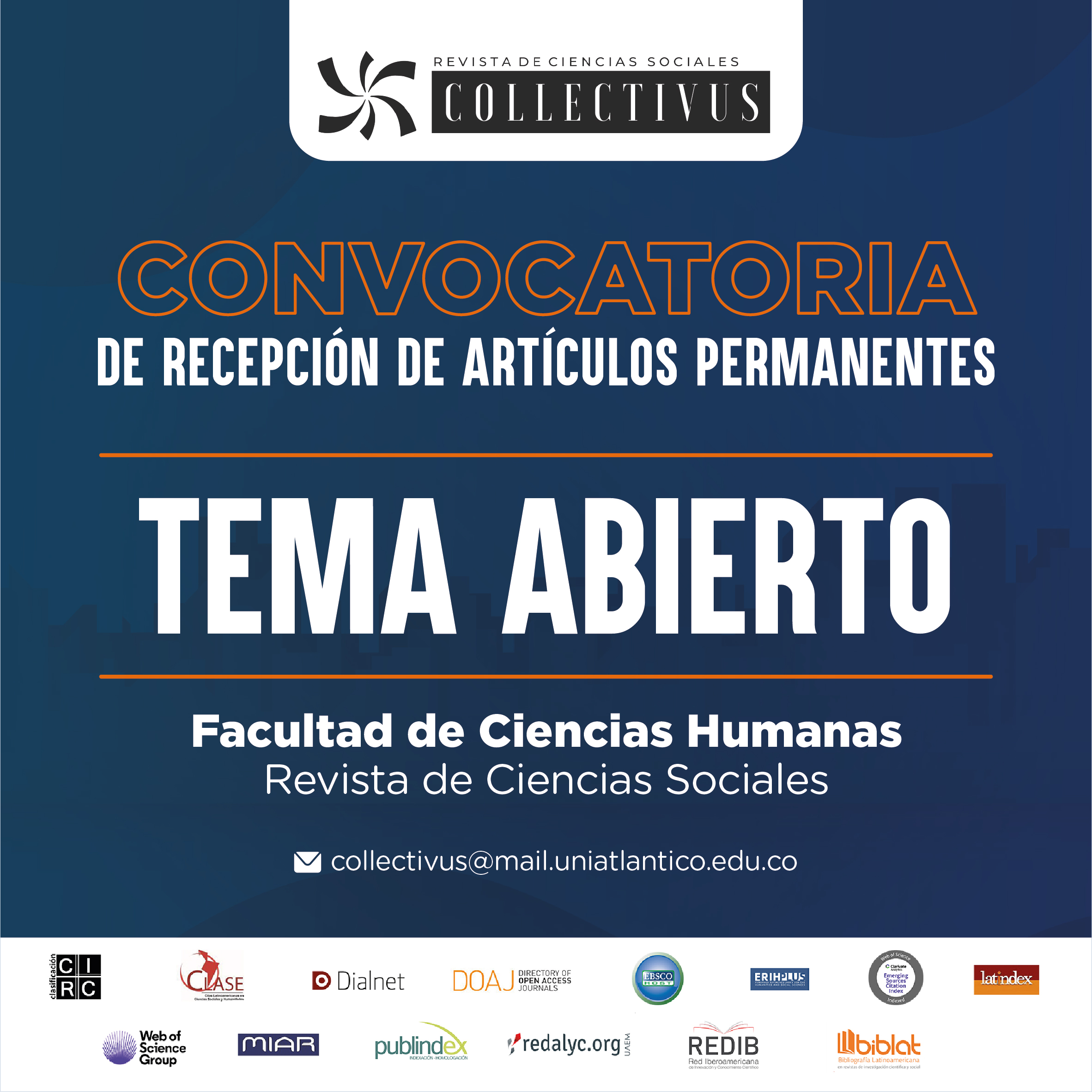




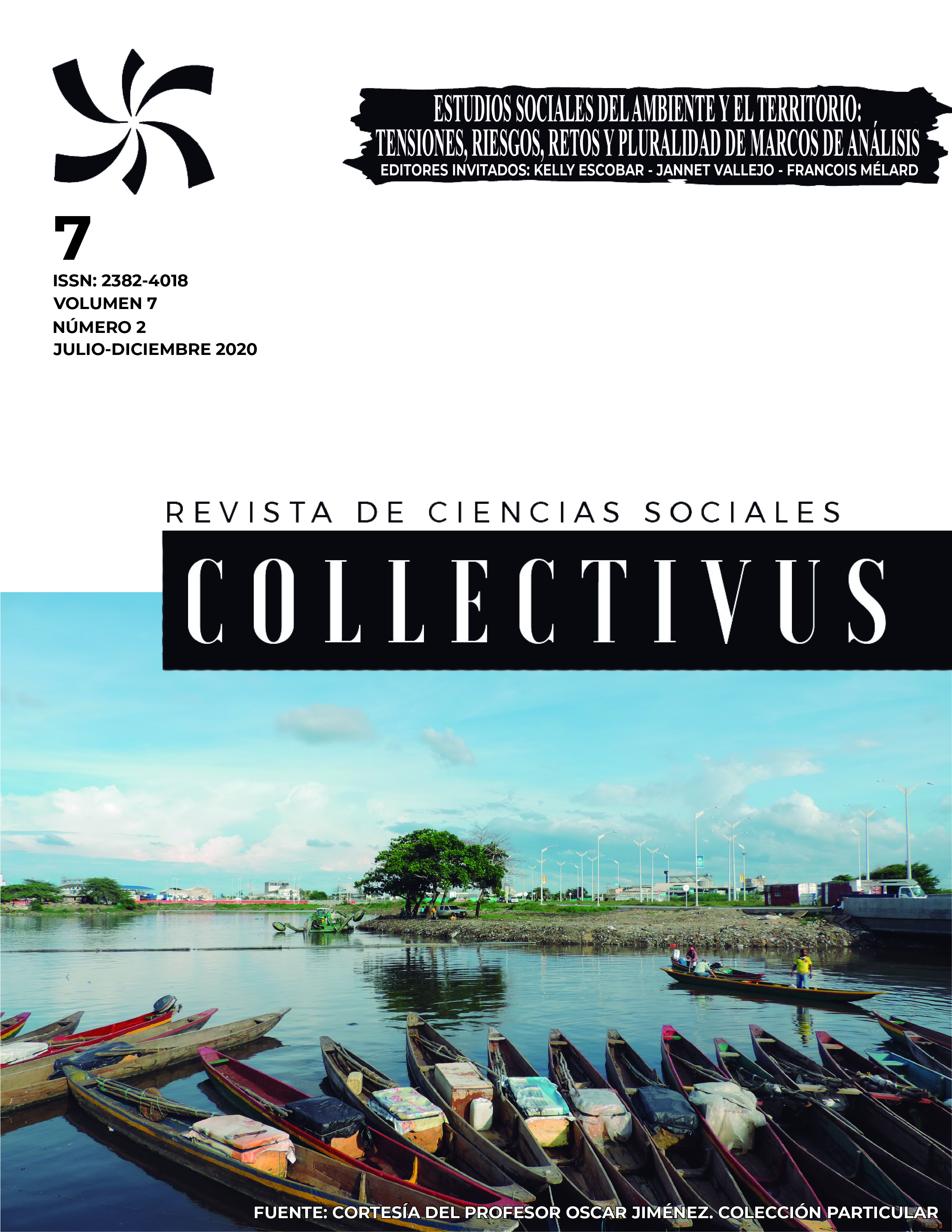


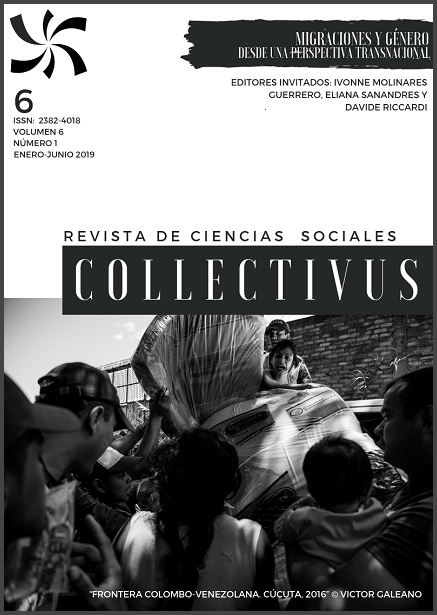






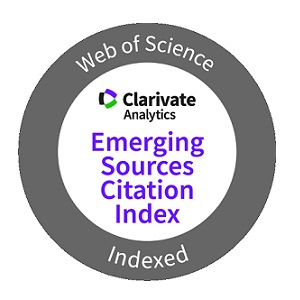



.jpg)
.PNG)



